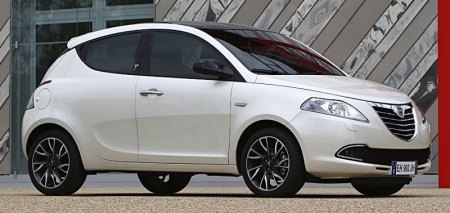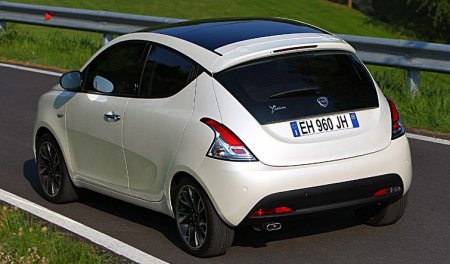3 years ago, we reported
that Fiat CEO Sergio Marchione planned to boost sales of his Lancia
division from 120,000 units to 300,000 units a year by 2010. That did
not materialize. Ironically, its sales actually dipped below 100,000
units last year, a record low since acquired by Fiat. Global economic
recession is not the one to blame. The lack of competitive products and
sensible strategies are. Promises about a new Fulvia and relaunching
Lancia in right-hand-drive markets were cancelled as Marchione focused
on his new, much larger investment, Chrysler. In fact, the integration
of Chrysler into the Fiat empire changed the landscape of Lancia
overnight. From now on, the Italian brand will sell a mixture of its
own cars (Ypsilon, Musa and Delta) and Chrsyler's vehicles (200, 300
and Grand Voyager) under its own badge in European continent. Vice
versa, these cars will become Chryslers in the UK and Ireland where
Lancia has been absent since 1993. Is it good to Lancia ? Frankly, I am
not sure. On the positive side, Lancia will immediately get access to
the UK and Ireland market without needing to spend heavily on setting
up sales and servicing networks. Its product portfolio also becomes
much more complete. On the down side, the vastly different character of
its American-sourced products may confuse customers on what the brand
stands for. This mean, in short term the collaboration might bring
extra sales immediately, but in longer term its success or failure will
depend on how their future products harmonize.

The new Ypsilon is the first product affected by the new strategy. In
other words, it will be sold as Lancia Ypsilon in Europe and Chrysler
Ypsilon across the English Channel. This is the first Lancia returns to
the radar screen of English motoring press. Nevertheless, I suppose the
Ypsilon line is no stranger to our readers. It was born in 1996 as the
direct successor of
Y10, then
entered the second generation in 2004. We were pretty impressed by the
Mk2's styling and packaging, because it
was designed as a more stylish and luxury alternative to Fiat Punto.
Italian felt the same too, otherwise they would not have snapped up the
majority production and kept Lancia surviving.
The Mk3 Ypsilon is no longer a sister car of Fiat Punto, because that
car has grown a lot in the process to become Grande Punto, whereas
Lancia
determined to keep its size unchanged. Therefore this time around it is
built on a stretched platform of Fiat 500 (as well as the next
generation
Panda). The new Ypsilon is a bit longer and taller than the old car,
but it is a bit narrower. Wheelbase is exactly the same at 2388 mm,
which keeps it at A-segment, though many motoring journalists
mistakably compared it with B-segment cars like Ford Fiesta and
Volkswagen Polo. The suspensions, steering, powertrains and electronics
are practically the same as its Fiat sister, which means development
cost concentrate on the exterior and interior packaging.

Outside, the car looks as distinctive and elegant as the last one. Its
prominent chromed radiator grille is a rare sight in mini cars,
delivering an upmarket image as intended. The clamshell bonnet is
mirrored at the other end by a clamshell tailgate, which looks pretty
stylish too. Ditto the taillights located at the rear shoulders. The
overall shape is noticeably curvier and more graphical than the past. I
particularly like the Ferrari 612-style concave surfaces pressed into
the doors, the chromed C-rings at the bumper intake and the
well-hidden rear doors. By the way, the new Ypsilon has changed from
3-doors to 5-doors in order to lure more family buyers.
Unfortunately, good design does not extend to the cabin. Look at the
picture below and you can't help doubting the taste of its interior
designers. I don't understand why they designed the instrument binnacle
to look as if pop up from the top of console (guys, it's not a sat nav
screen !), neither can I praise the aftermarket-like center console. It
seems that Fiat's Turin design HQ has failed every interior design in
recent years, with the exception of Fiat 500 perhaps. Lorenzo
Ramaciotti had better to think about it.

Not just interior design, the ergonomics and build quality are also
doubtful. The Ypsilon shares some of the faults of the 500, namely, the
lack of telescopic steering wheel and a high-mounted gearstick that
robs your knee room. Furthermore, the piano-black console surface
causes reflection on sunlight. The centrally-mounted instruments
are not as easily visible as traditional ones. The driver seat is too
high even at its lowest position, although that might be expected for a
cute city car. Visibility is compromised by small glass area, and the
cabin looks darker and more confined than in 500. At the quality side,
the car tries to be more luxurious than Fiat, but the thin layer of
vinyl covering the dash top and doors is no replacement to soft-touch
plastics, and the switch gears are cheaper than Lancia wants you to
believe. Cabin room, however, is better than expected. Thanks to the 88
mm extension in wheelbase, its rear seat can accommodate a pair of
sub-six-footers. Rear knee room is quite generous for such a small
car.
The car offers only 3 engines to choose from: 69hp 1.2-liter 8-valve
FIRE, 85hp 875cc MultiAir twin-cylinder turbo (TwinAir) and 95hp
1.3-liter 16V Multijet turbo diesel. Sadly, none of them match the
luxury pretension of the car. The well-proven FIRE is the most refined,
but it lacks punch to deliver the motorway overtaking we prefer. The
twin-cylinder engine is a technical tour de force. It should combine
greenness with accessible performance. In reality, frugality can be
achieved only at Eco mode, which limits rev and output. Otherwise the
engine is nowhere as frugal as claimed. Moreover, while the unique
twin-cylinder note adds to its character, it is vocal to the extent of
annoying on motorway cruising. At low rev, there is some vibration
transmitted into the cabin. It might be a great city car engine, but
not suitable to the luxury-biased Lancia. The 1.3 Multijet is a little
better, but you can still criticize for its excessive noise at push as
well as the nose-heaviness and harsher ride brought by its extra
weight. Our message to Lancia: please bring the 1.4 MultiAir on board !

As expected, chassis dynamics bias towards the comfort side. Its
combination of tall body and soft suspension results in pronounced body
roll in corners. If you drive quick enough, it will understeer. On the
flip side, the ride is smoother than its Fiat sister, if not
exceptional over bigger bumps. The steering is light and easy to drive
in town, if a little remote. Overall, it is more comfortable but less
fun to drive than Fiat 500.
The Ypsilon is not going to be a class leader. It cries for a better
interior, a better engine and more sparkles from the chassis. However,
if you want a stylish and upmarket-looking city car that is also
capable to seat four adults, there seems to be few alternatives. Taking
price into account, the baby Lancia is even harder to beat. That's the
advantage of being niche.